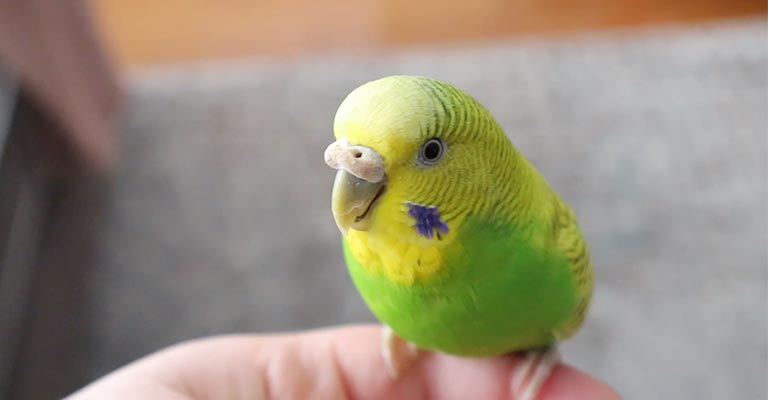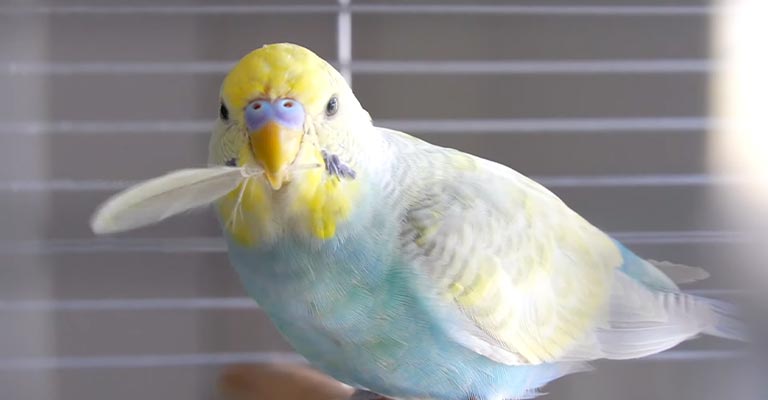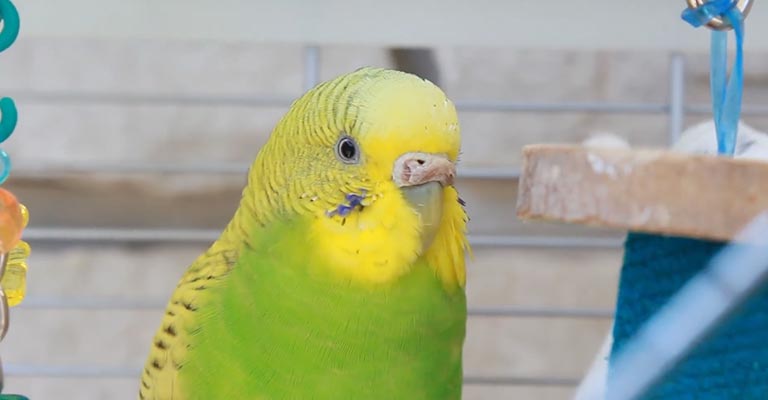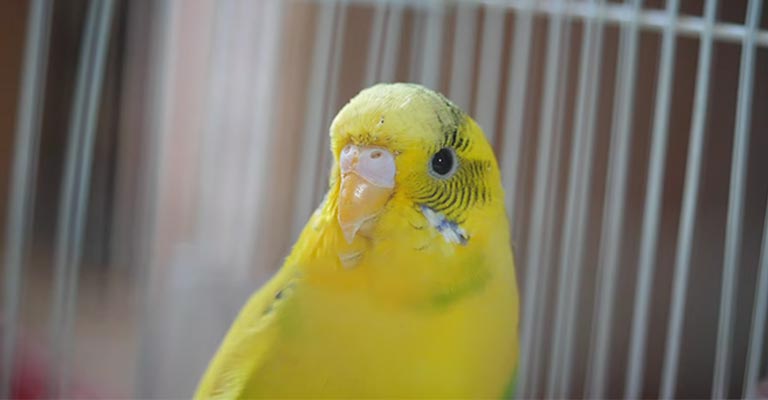Have you ever noticed a peculiar change in your budgie’s nose color, leaving you scratching your head in bewilderment? Wondering why is my budgie’s nose brown.
Budgie owners often find themselves perplexed when their feathered friends sport an unexpected brown hue on their noses.
In this exploration, we delve into the fascinating world of budgie health and behavior to uncover the reasons behind this enigmatic phenomenon.
A budgie’s nose, or cere, serves as a crucial indicator of its well-being, and any alteration in color can signal underlying factors.
From diet and environmental influences to potential health issues, we navigate through the various possibilities that might contribute to this intriguing transformation.
Join us on this feathered quest as we demystify the mystery of brown noses in budgies, providing insights to help you better understand and care for your colorful companions.

Why Is My Budgie’s Nose Brown?
Your budgie’s brown nose may seem perplexing but fear not—let’s embark on a comprehensive exploration to unravel the mystery behind this intriguing phenomenon.
Natural Variations
Budgies, like humans, exhibit natural variations in pigmentation. The cere color can change due to age, sex, and genetic factors. Young budgies typically have a softer, lighter-colored cere that may darken as they mature.
Additionally, male and female budgies have different cere colors. Males often have a vibrant blue cere, while females display a browner or tan hue.
Hormonal Changes
Hormonal fluctuations can also impact the color of your budgie’s nose. During breeding season or when hormonal changes occur, the cere may undergo color shifts.
In males, the cere can become darker and more intense, while females may experience changes in hue as well. Understanding your budgie’s hormonal cycles is essential for interpreting these color variations.
Dietary Influences
The food your budgie consumes plays a crucial role in its overall health, including the color of the cere. A well-balanced diet rich in essential nutrients contributes to a healthy and vibrant appearance.
Conversely, deficiencies in certain vitamins or minerals may manifest as changes in cere color. Ensure that your budgie’s diet includes a mix of high-quality seeds, fresh fruits, and vegetables to promote optimal health.
Environmental Factors

The environment in which your budgie lives can also impact its cere color. Exposure to natural sunlight is essential for budgie health, as it helps in the synthesis of Vitamin D.
A lack of sunlight or insufficient UV lighting in the cage may affect the bird’s overall well-being, potentially leading to changes in cere color. Providing a well-lit and stimulating environment is crucial for your budgie’s physical and mental health.
Health Considerations
Changes in cere color can sometimes indicate underlying health issues. Respiratory infections, mites, or other illnesses may manifest as alterations in the cere.
If you observe persistent changes in color accompanied by other signs of distress, such as lethargy or changes in behavior, it’s crucial to consult with an avian veterinarian promptly. Early detection and treatment can significantly improve the chances of recovery.
Mating Behavior
If you have multiple budgies in the same environment, mating behavior can influence cere color. A budgie in breeding condition may display more intense and vibrant cere colors.
Understanding the social dynamics and interactions among your budgies can provide valuable insights into the reasons behind changes in cere color.
Observation and Monitoring
Regular observation of your budgie’s behavior, eating habits, and overall demeanor is key to identifying any potential issues. Keep a close eye on the cere color, noting any gradual or sudden changes.
This proactive approach allows you to address concerns promptly and seek professional advice if needed.
In essence, the brown coloration of your budgie’s nose is a multifaceted puzzle with various pieces contributing to the overall picture.
By considering natural variations, hormonal changes, diet, environment, health factors, and social dynamics, you can gain a holistic understanding of your budgie’s well-being.
What to Do If My Budgie’s Nose Turns Brown?

If you notice your budgie’s nose turning brown, it’s essential to address this change in pigmentation promptly.
While budgies can have variations in their cere color, a sudden or pronounced change may indicate an underlying issue. Here’s what you should do if your budgie’s nose turns brown:
Observe the Change
Start by closely observing the brown coloration. Note when it first appeared, its intensity, and whether it seems to be spreading. These details can be helpful when discussing the issue with a veterinarian.
Check for Health Signs
Examine your budgie’s overall health. Look for signs of illness, such as lethargy, changes in droppings, sneezing, or labored breathing. A brown cere could be associated with an underlying health problem.
Assess Diet and Nutrition
Ensure your budgie is receiving a balanced diet. A poor diet can lead to health issues and changes in cere color. Budgies require a mix of seeds, fresh vegetables, and clean water.
Consult with an avian veterinarian or bird specialist to tailor a suitable diet for your specific budgie. Evaluate your bird’s living conditions.
Ensure the cage is clean, and there are no irritants like dust or fumes in the environment that could be affecting your budgie’s health.
Gender and Age
The color of a budgie’s cere can change with age and gender. Males typically have blue cere, while females have brown or beige.
Juvenile budgies may also have different-colored ceres until they mature. Make sure you accurately determine your budgie’s gender and age to understand these natural variations.
Consult an Avian Veterinarian
If you’re concerned about the brown color of your budgie’s cere, it’s advisable to consult an avian veterinarian.
They can perform a thorough examination, including blood tests, to identify any underlying health issues. Common causes of cere discoloration can include infection, mites, tumors, or hormonal imbalances.
Treatment
Once the veterinarian identifies the cause, they will recommend appropriate treatment. This could include medications, dietary adjustments, or environmental changes. Follow their guidance diligently to address the issue effectively.
Preventive Care
To maintain your budgie’s health and prevent cere discoloration in the future, provide regular check-ups and a healthy, balanced diet. Keep their environment clean and ensure they have mental and physical stimulation through toys and social interaction.
What Does an Unhealthy Budgie Beak Look Like?

Recognizing signs of an unhealthy budgie beak is crucial for proactive avian care. The beak serves not only as a tool for eating but also as a reflection of the bird’s overall health.
Various conditions can affect a budgie’s beak, and understanding the signs can help you address issues promptly. Let’s delve into what an unhealthy budgie beak might look like and the potential underlying causes.
Overgrown Beak
An overgrown beak is a common issue in budgies and can result from a lack of proper wear.
In healthy budgies, the upper and lower beaks naturally wear down through chewing on toys and consuming a variety of foods. However, if the beak becomes overgrown, it can hinder the bird’s ability to eat and lead to nutritional deficiencies.
Uneven Beak Growth
Uneven beak growth, where one side of the beak is longer than the other, can indicate a problem with the bird’s jaw alignment.
This misalignment may be congenital or the result of an injury. It can lead to difficulty in grasping and manipulating food, affecting the budgie’s overall feeding capability.
Discoloration
A healthy budgie’s beak is usually smooth and uniform in color. Discoloration, such as darkening or changes in pigmentation, may be a sign of underlying health issues.
Fungal or bacterial infections, liver problems, or certain nutritional deficiencies can contribute to abnormal beak color.
Flaking or Peeling
If you notice flaking or peeling on the surface of the beak, it could indicate a nutritional deficiency or a health problem.
Budgies require proper levels of vitamins and minerals, particularly Vitamin A, for healthy beak development. A lack of these essential nutrients may result in flaking or peeling of the beak.
Swelling or Puffiness
Swelling or puffiness around the base of the beak can be a sign of an underlying infection. Respiratory infections or mites may lead to inflammation, affecting the tissues around the beak. It’s important to address any swelling promptly to prevent the condition from worsening.
Cuts or Abrasions
Budgies are active birds and injuries to the beak can occur, especially if they engage in rough play or if there are sharp edges in their environment.
Cuts or abrasions on the beak may lead to discomfort and difficulty eating. Ensuring a safe and hazard-free environment is crucial to prevent such injuries.
Changes in Beak Shape
Any noticeable changes in the shape of the beak, such as bending or deformities, may indicate an underlying health issue.
Genetic factors, injuries, or metabolic disorders can contribute to alterations in beak shape. Monitoring your budgie’s beak regularly allows you to detect such changes early on.
Excessive Beak Grinding
While occasional beak grinding is normal, excessive or constant grinding can be a sign of pain or discomfort.
This behavior may indicate dental issues, jaw problems, or other health concerns. If you observe persistent beak grinding, consulting with an avian veterinarian is advisable.
Difficulty Eating
If your budgie is having difficulty picking up or manipulating food, it could be a sign of beak problems.
This may include beak misalignment, overgrowth, or pain associated with an underlying health issue. Observing eating habits is crucial in detecting potential beak-related issues.
Changes in Beak Texture
A healthy budgie beak is typically smooth and hard. Changes in texture, such as softening or roughening, may indicate health issues. Nutritional imbalances, fungal infections, or metabolic disorders can affect the texture of the beak.
FAQs
Why is my budgie’s nose turning brown?
Budgie nose color can change due to factors like age, gender, hormonal shifts, and even diet. It’s essential to observe other behaviors and consult a vet if you notice persistent changes.
Can I use over-the-counter medications to clear my budgie’s nose?
It’s not recommended to use OTC medications without veterinary guidance. Some substances can be harmful to birds, and a vet can prescribe safe and effective treatments based on the specific condition.
How can I prevent respiratory issues in my budgie?
Maintain a clean and well-ventilated environment, avoid drafts, provide a balanced diet, and ensure proper hydration. Regular vet check-ups can help detect potential issues early on.
Should I be concerned if my budgie sneezes occasionally?
Occasional sneezing is normal, but if it becomes frequent or is accompanied by other signs like discharge, it’s advisable to consult with a vet. It could indicate respiratory issues that need attention.
Can I use a humidifier to help my budgie with nasal congestion?
Yes, a humidifier can create a more comfortable environment for a budgie with nasal congestion. Ensure it’s placed safely away from the bird and consult with a vet to determine the appropriate level of humidity for your budgie’s health.
Conclusion
While a brown nose on your budgie may initially raise concerns, it’s essential to approach the issue with a curious and informed mindset.
The color change in the cere can be attributed to a range of factors, from natural variations and hormonal shifts to dietary elements and potential health issues.
As responsible budgie caregivers, staying attuned to these subtle changes allows us to provide the best possible care for our avian friends. Regular vet check-ups, a balanced diet, and a nurturing environment contribute to the overall well-being of your budgie.
Remember, each budgie is unique, and understanding their individual needs and behaviors is key to ensuring a happy and healthy life for these charming feathered companions.
So, embrace the mystery, stay vigilant, and continue to enjoy the delightful company of your budgie with newfound knowledge and confidence.